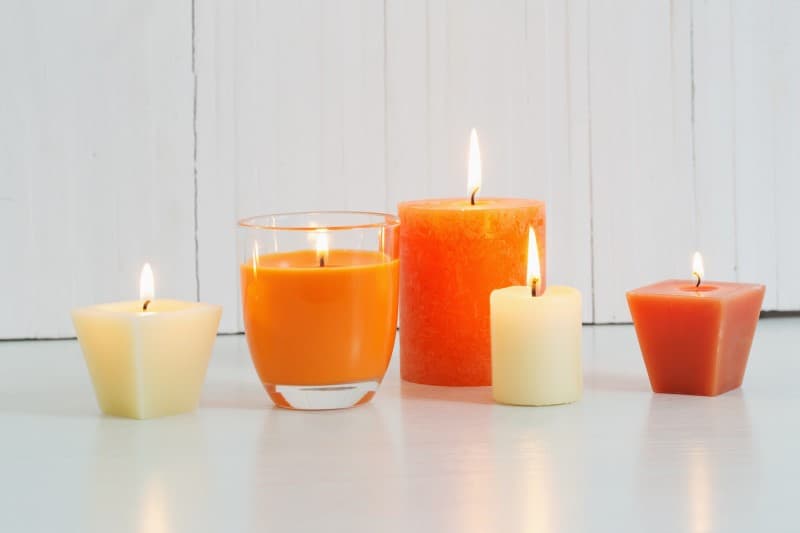When I first started making soy candles, I realized quickly I had forgotten to buy dye for the candles. I was debating on making a trip to the craft store when I remembered I had food coloring in the pantry. I decided instead of going to the craft store, I was going to try to dye my candles with the food coloring.
Food coloring is a good way to dye candles, except when it is in liquid form. Liquid food coloring is water-based and will not mix with the wax. In order to successfully use food coloring, it has to be in gel, paste, or powder form because it is capable of mixing in with the wax instead of separating.
When in a pinch, food coloring can be a good way to dye a candle as long as it is not a liquid coloring. While liquid food coloring is not an option for dying candles, there are other dyes that can be used effectively for soy candles.

Food Coloring in Soy Candles
To dye a soy candle with food coloring, you need to make sure you are using gel, paste, or powder form. Liquid food coloring is water based.
Candle wax is composed of oils so liquid food coloring will separate from the wax, much like what happens when trying to mix oil and water together.
When adding liquid food coloring to the melted wax, the coloring forms into beads and promptly sinks to the bottom of your container.
Stirring the wax and the food coloring does not help because the food coloring beads split into more and more beads instead of dying the wax. In the end, instead of having dyed wax, you will end up with the original color of wax with beads of food coloring.
While the liquid food coloring may look like it adds a cool beaded effect to the wax, if you pour the wax out into a jar to set, the food coloring will not pour out with it.
Just like with regular water and wax, the liquid food coloring is more dense than the oils that make up the wax so the food coloring will settle its way to the bottom of the container you have mixed the wax and coloring in.
So, when you are pouring the wax out into the jar, the food coloring will be trapped under the lingering wax and, therefore, the majority of the coloring will not make it into the jar.
By using a gel or paste food coloring, you are going to have a much easier candle dying experience.
These types of food colorings are oil based, which means they will mix into the wax much easier. With this method, a small amount of food coloring goes a long way. When the wax is hot, add in your food coloring in small amounts.
Once the coloring is completely dissolved into the wax, add more if you would like a deeper or more vibrant color.
Another type of food coloring you can use is a powder food coloring. From the coloring being in a powder form, it will be easy to mix and dissolve into the wax. Again, a small amount of this coloring goes a long way, so add a small amount at a time.
While you can use gel, paste, and powder food coloring when you need to, they are not meant for dying candles and should be used only when needed.
While some types of food coloring can dissolve and dye candles easily, the ingredients in the food coloring are not made with the intention of them being near an open flame. With this warning in mind, there are better methods of dying your candles. Some kinds of dye I would recommend are:
- Liquid candle dye
- Dye flakes
- Natural methods
Using Dyes Created for Candles
Now that we have figured out that food coloring is not the best way to dye our candles, we need to figure out what the best method is.
There are several different kinds of dyes created specifically for dying candles. One of the easiest forms of candle dye to use is the liquid candle dye. With this kind of dye, you do not need to worry about having to mix vigorously to prevent any sediment like you would have to with powder candle dye.
When using liquid candle dye, you have to decide how dark or light you want your candle to be. If you want a lighter colored candle, use about three to four drops of dye and for a darker candle, use about six or seven drops of dye. The dye spreads quickly so it does not take much stirring for the candle to be completely dyed.
Another form of candle dye are dye flakes. There are dye flakes that are created specifically for soy candles, which in our case would work wonderfully.
Dye flakes are a very easy method to use that comes in a wide variety of colors. With this method, you can add the flakes while you are melting the wax or you can mix it in after the wax is already melted. Also, a small amount of flakes goes a long way, so use sparingly!
Dying Candles Naturally
Candles can be dyed naturally without the use of artificial dyes. Be warned, though, this is not the quickest method for candle dying! If you have the spare time and patience, though, this is a good method if you would like to use items you may just have in your household.
For example, paprika can be used to dye your candle a pastel red. Keep in mind, dying a candle naturally is not going to give you as vibrant or deep of a color as artificial dyes will.
If you decide you want to use this method, you will need a few household items. You will need a coffee filter, string, and the natural ingredient you are using as a dye. Put the dying ingredient into the coffee filter and tie it closed with the string.
Make sure you have tied it tight so none of the dying ingredients leaks out into the wax. Now here is where the time consuming part comes in.
Completely submerge the dye bag you created into the wax and let it steep for several hours. The longer you leave the dye bag in the wax, the darker the color will be. Regardless, expect your wax to be dyed a pastel color.
I would definitely recommend this method if you want to stay away from artificial dyes. While the process takes longer, the end product is rewarding and is free of unnatural dyes. Also, this is a great method if you love pastel colors!
Using Crayons to Dye Candles
A common solution to not having candle dye is to use crayons. While crayons are a good method for getting a bright or deep color, the crayon wax does not normally fully dissolve into the soy wax.
This leaves the candle with chunks of crayon accumulating at the bottom and can sometimes lead to the color not being evenly distributed.
Another downside to using crayons to dye your candles is that the wax from the crayons prohibits the candle from burning proficiently.
When a candle has crayon wax in it, the flame will extinguish in a short period of time. These two reasons are why I would not recommend the use of crayons to dye your candles.
While it can provide a vibrant or deep color, the consequences of the crayons are not worth your candle not being evenly colored or unable to burn.
Related Questions
Can I use Rit dye to dye candles?
Rit dye can be used to color candles! The brand provides many different colors to use but it should be noted that in order to dye candles with this brand, it needs to be their all-purpose powder dye.
Can you use soap dye for candles?
As a rule of thumb, dyes with glycerin in the ingredient list should not be used to dye candles because they attract water and the end result will be similar to that of liquid food coloring.
Read more:
